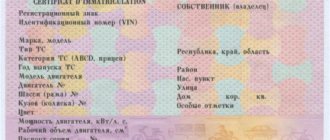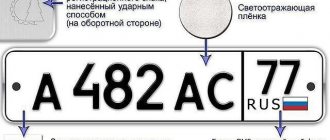The country's traffic regulations oblige drivers to carry a number of documents when driving on the country's roads. They must confirm the legality of the car and the person’s right to drive it. These documents include a certificate confirming the vehicle’s state registration. Every owner knows well what a vehicle registration certificate is, but not everyone understands why this document is needed.
What is a vehicle registration certificate?
Appearance of STS
The document has a standard form, which is common throughout the country. It changes periodically. Currently, the traffic police issues a document that is a plastic card measuring 80x115 mm. It is filled out on 2 sides, each of which contains information about the vehicle, allowing you to check its legality.
Sample STS
Table. Information contained in the STS
| Front side | back side |
| Document's name | Vehicle owner |
| Vehicle registration number | Republic, region or region |
| Car make and model | Area |
| Vehicle category | Locality |
| Year of issue | Street |
| Engine number | House, building, apartment |
| Chassis number | Special marks |
| Body number | Issuing authority |
| Car color | Certificate issue date |
| Engine power | |
| Engine displacement | |
| PTS number and series | |
| Permitted vehicle weight with and without load |
The number and series of the document are indicated on both sides of the certificate. Information about the car and its owner is applied to the finished certificate form using a printer. The document is protected by a hologram. It is located at the top of the card. When ultraviolet rays are pointed at the hologram, it begins to glow in a bright light green color. The document bears the signs of the Ministry of Internal Affairs and the State Traffic Safety Inspectorate. The inscription “Russian Federation” is framed by a microscopic inscription.
Reference. In the near future, the traffic police plans to replace the old STS form. The document will take the form of a plastic card measuring 85.6x54 mm.
New vehicle registration certificate
The new STS will become an intermediate option until the introduction of digital documents. Registration certificates in the near future will be equipped with chips containing information about the vehicle. The transition to new documents in Russia will take place in parallel with the EAEU countries. This is a coordinated interstate decision made as part of the general planned transition of the Union member countries to digital technologies. Together with the STS, the PTS will also acquire an electronic appearance. The process of transition to new forms of documents will start in October 2019.
Fundamental differences between PTS and STS
Both documents contain information about vehicles and their owners. In the registration certificate, it is compressed to the minimum necessary to verify the legality of the car by traffic police officers. The PTS is a vehicle passport containing more complete information about the vehicle. Unlike STS, which is subject to exchange after a change of owner, PTS is issued for equipment upon release and serves until it is disposed of. Based on the information entered in the technical passport, you can not only establish the legality of the vehicle, but also trace the history of its operation.
PTS and STS
Documents vary in size and color. The laminated STS card has a pink tint. The PTS is an A4 document, colored blue. In its production, the paper lamination technology that is used for STS is not used. The registration certificate contains information about the authority that issued the document. This data is not included in the vehicle's technical passport. Instead, the document contains information about the vehicle manufacturer. When importing equipment from another country, a mark from the customs authority is placed in the PTS.
Normative base
The requirements for the production of a vehicle registration certificate and the procedure for its issuance are regulated by various regulations. Among them:
- PP No. 938 dated 08/12/1994;
- Federal Law No. 117 of 08/05/2000;
- Code of Administrative Offences;
- PP No. 1090 dated October 23, 1993
Important. From August 2021, a new vehicle registration procedure will come into effect in the country. Now it will not be possible to issue STS to persons under 16 years of age.
Video – STS
What is STS for a car?
The car owner must have documents confirming the ownership of his PTS and STS, which stand for:
- Vehicle Passport;
- Certificate of registration of the Vehicle.
Both documents contain complete information about the vehicle and its owner. At their core, they duplicate each other.
But the significant thing is that it is impossible to restore the PTS with only the STS, so it is better to leave it at home and have only the STS with you.
- The certificate is printed on a strict accounting form, protected by several degrees from forgery.
- It contains the characteristics of the vehicle in accordance with information from the title and information about the owner of the car.
- The form has convenient storage dimensions - 80 x 115 mm. This is significantly smaller in size than the PTS. The certificate is usually laminated to maintain its appearance throughout its shelf life.
Is it possible to drive without a registration certificate?
Current legislation does not allow drivers to drive on the country's roads without STS. The absence of a document is considered a traffic violation. Various types of punishment for drivers not having a plastic certificate card are defined by the Code of Administrative Offences. The document is drawn up when the car is registered with the state. This must be done no later than 10 days from the date of purchase of the vehicle. This period is established by PP No. 938. During this period, the driver can drive on the roads of the country with a title, a compulsory motor liability insurance policy and a car purchase and sale agreement.
Documents for the car
Important. Late registration of vehicles with the state and the absence of vehicle registration certificates are subject to administrative liability.
The amount of the fine for this type of traffic violation is determined by Article 12 of the Code of Administrative Offenses. Its minimum amount is 500 rubles. The driver's lack of a registration certificate is sufficient grounds for detaining the car and sending it to a impound lot. When faced with such a situation, many drivers do not know what to do correctly. There are 2 ways to avoid vehicle seizure:
- ask someone to drive the STS to the place where the car stops;
- present the PTS to the traffic police officers.
Having a PTS will allow you to continue your journey further behind the wheel of your car. In this case, the only punishment for violating traffic rules can be a warning, which will be issued by traffic police officers at the place where the car is stopped to check documents.
Checking documents by a traffic police officer
Most drivers receive harsher penalties. They have to pay fines for lack of documents, the amount of which depends on the type of traffic violations. If the vehicle registration period is overdue, the fine ranges from 1,500 to 2,000 rubles. The procedure for his appointment is determined by Article 19.22 of the Administrative Code. If a traffic violation is repeated due to the driver not having a vehicle, the fine increases to 5,000 rubles.
Issuing the first fine is not an obstacle to issuing a second one within one day or even an hour. Without a vehicle registration certificate, the driver does not have the right to drive a vehicle. A more serious punishment for driving without an STS is the deprivation of your driver's license. The driver may lose the right to drive a car for up to 3 months.
Towing a car to a parking lot
The rights of traffic police officers to detain the car of traffic violators and send it to the impound lot are determined by Article 27 of the Code of Administrative Offenses. The law imposes on them the responsibility to check the legality of cars moving on the country's roads. If the driver does not have STS, the vehicle cannot be released by traffic police officers until it is checked for theft.
You can find out more about what penalties are provided for driving without STS by reading the article on our website.
Changes in the administrative regulations of the traffic police
When and who needs to register a motorcycle with the traffic police
The new owner or his representative must register the two-wheeled vehicle with a power of attorney certified by a notary.
The countdown of the registration period does not depend on the place where the bike was purchased:
- In Russia – 10 days from the moment of concluding the contract or receiving a receipt from the store.
- Brought from abroad - 10 days from the date of receipt of customs documents.
All models of motor vehicles with a power exceeding 50 horsepower are subject to mandatory registration.
Pit bikes and motocross motorcycles do not require registration. They are not adapted to traffic conditions on public roads due to the lack of rear-view mirrors and turning lights. Having spotted such a vehicle in the city, traffic police officers can seize it and send it to the impound lot.
The exception is certain types of crossbikes, which can still be registered and ridden on public roads. These are supermoto and enduro motorcycles.
Also read: Is it possible to return a car to a car dealership: how and when to do it
The procedure for obtaining and replacing a document
The obligation of vehicle owners to register them with the state is determined by the Civil Code of the Russian Federation and traffic rules. A registration certificate is issued every time the owner of a vehicle changes. This is done at the traffic police department. Reforming the current legislation involves changing the existing procedure for obtaining a document. It is planned to create specialized organizations in the country that will assume responsibility for performing these functions. Currently, the previous procedure for obtaining new and replacing old STS is in effect.
Step-by-step instructions for obtaining a vehicle registration certificate
Step 1. At the first stage of the STS registration process, a package of documents is prepared. It includes: a purchase and sale agreement, a receipt for payment of the state duty, a vehicle title and an internal passport of the vehicle owner.
Package of documents for obtaining STS
Step 2 . A prerequisite for obtaining a vehicle registration certificate is payment of the state fee. You can pay it through banks or the State Services portal. The last method of paying the fee allows you to save 30% of money.
Sample receipt of payment of state duty
Step 3. The collected package of documents and a receipt for payment of the duty are submitted to the traffic police at the place of registration of the car.
Submitting documents to the traffic police
Step 4 . Before issuing an STS, traffic police officers check the documents and the vehicle. Vehicle inspections are carried out at special sites designed for these purposes.
Vehicle check
Step 5. The last stage of the procedure is to obtain the STS.
Obtaining STS from the traffic police
The procedure for obtaining a duplicate or replacement of a vehicle registration certificate
STS has to be replaced for various reasons. One of them is buying a car. The current procedure in the country allows vehicle owners to sell them without deregistration. The new owner of the car can change the car registration certificate without the presence of the previous owner. He must do this within 10 days after making the purchase. The countdown starts from the date specified in the contract. You can submit documents to receive STS:
- personally;
- with the help of third parties;
- through the State Services portal.
In practice, there are situations when applicants are refused to issue a document. Among the reasons for making such decisions by traffic police officers:
- lack of a compulsory motor liability insurance policy;
- providing false documents;
- lack of payment of state duty.
Sample application to the traffic police (
)
A justified refusal to issue an STS cannot be appealed in court. Current legislation provides for cases of issuing a duplicate registration certificate. These include:
- loss of STS as a result of dilapidation or theft;
- changes in the name or registration of the owner of the vehicle:
- engine replacement.
Order of the Ministry of Internal Affairs No. 605
According to Order of the Ministry of Internal Affairs No. 605, obtaining a duplicate certificate is considered a registration action. Replacing the STS takes several hours if the document is not stolen. The theft of a certificate is grounds for initiating a criminal case. Until it is closed, you will have to travel with a certificate, which is issued by the traffic police instead of a plastic card. Knowing such subtleties, many drivers do not report theft, but explain the situation by the loss of a document. The application for the issuance of an STS submitted to the traffic police must contain complete information about the vehicle and its owner.
Current legislation allows you to apply for an STS at any traffic police department in the country. The obligation of vehicle owners to replace the vehicle registration certificate when changing their place of residence is determined by Order of the Ministry of Internal Affairs No. 1001. The procedure for paying the duty when replacing STS is determined by Article 333.33 of the Tax Code of the Russian Federation. The current regulations exempt the duty from the commission fee. Old STS, after they are handed over by the car owners, are disposed of by traffic police officers. The fact of destruction of vehicle registration certificates is documented in an act in the established form.
The procedure for replacing a certificate depends on the chosen method of carrying out the procedure. When submitting documents through the State Services portal, you cannot avoid visiting the traffic police. Inspection of the vehicle is a mandatory procedure when obtaining a certificate. The advantage of the services provided by the portal is the ability to schedule an inspection of the car at a time convenient for its owner.
State Services Portal
When submitting documents for replacement or receipt of STS through State Services, a receipt for payment of the duty is automatically generated on the website. This saves car owners from having to look for payment details. You can pay the fee on the portal not only using a bank card, but also with electronic money.
More information about the new procedure for registering a vehicle and obtaining an STS for it can be found in the video:
Video - New rules for vehicle registration
Rules for issuing a certificate
You need to register your car and receive the corresponding document at the registration department of the traffic police. After purchasing a new car, it must go through the registration procedure; this is an indispensable condition for using the vehicle on the roads of the Russian Federation.
What should you take with you?
- Registration certificate (PTS), which it is advisable to copy, like other documents.
- Agreement confirming the purchase and sale. You also need to take a document indicating the total cost of the purchase.
- OSAGO policy. The car must be insured before receiving the STS.
- As usual, you can’t do without a passport and driver’s license.
- Before registering a vehicle, you will have to pay a state fee. You must also take the receipt with you.
Important! The cost of registering a new car is 500 rubles. Moreover, as with any other payment for government payments, you can get a good discount when paying through the State Services portal. The discount will be 30% of the total amount.
It is worth remembering that a driver can use his new car for several days without registration. The law gives 10 days to get to your place of residence if the car was purchased in another city and complete all registration steps. In order not to raise questions at traffic police posts, you just need to carry with you a contract that confirms that the car was purchased and not obtained illegally. You also need a check or some other document confirming the fact of payment.
After all the necessary documents have been provided to the traffic police, the car is thoroughly checked. The history of the car is being studied for involvement in any illegal manipulations or crime. Then an STS and, if necessary, a registration plate are issued.
Decoding STS
The series and document number of the vehicle registration certificate are linked to the title. They allow you to determine the legality of the vehicle’s origin. To designate a series, 2 letters are used. The number consists of the same number of digits. You can find them below on the front side of the plastic card. The state number indicated in the STS, assigned to the vehicle upon registration, also consists of letters and numbers. It is a code by which traffic police officers can obtain certain information without stopping the car for inspection. For example, by using a car’s license plate, you can determine the region of registration of the vehicle and the status of its owner. License plates with the EKH series are issued to vehicles belonging to the FSO. Cars of the Office of Presidential Affairs receive license plates with the series:
- AOO;
- MOO;
- SBI;
- SOO.
FSO car
The selection of numbers and letters in license plates is regulated by GOST R-50577-93. The information about the issuing authority specified in the STS must be included in the vehicle purchase and sale agreement. They are important in case of doubts about the legality of the vehicle. The information contained in the registration certificate is of practical importance. Based on data on the vehicle's power, the amount of transport tax is determined. They also influence the cost of the insurance policy.
What does STS look like and what information does it contain?
A vehicle registration certificate is an official document, printed on a special form (issued for vehicle registration certificates) and has several levels of protection. The registration of such paper is mandatory for the owner of the car.
Externally, the vehicle registration certificate is a small card with data on the front and back. On the front there is information about the car (VIN, color and other characteristics), and on the back there is information about the owner and the traffic police department where the car was registered.
The size of the vehicle registration certificate (certificate) is 75 by 100 mm. Thanks to its compactness, it easily fits into any pocket or purse. At the same time, lamination provides reliable protection from negative natural influences.
On a sample of the front side of the STS of the car you can see the following data:
- Register sign. The vehicle registration certificate is marked with a special set of characters. It is formed from 2 components. Three letters and the same number of numbers are written on the left, and the code of the region of the Russian Federation on the right (it includes two or three characters). Next, the flag of Russia and the English abbreviation of the name of the state (RUS) are drawn. On the sample vehicle registration certificate you can see no more than 12 characters consisting of letters of the Russian alphabet. They are selected in such a way that there is the possibility of duplication with Latin letters. In STS, A, B, E, K, M, N, O, P, C, T, U, X are used.
- VIN code of the car. As in the PTS (technical passport of the vehicle), the identification number of the car is registered in the STS. When displaying this information, it is allowed to use numbers from zero to nine and Latin characters. The prohibition concerns letters, the use of which may lead to incorrect interpretation. We are talking about I, Q and O. This decision was made to avoid confusion with one or zero. The VIN code includes three elements - the manufacturer's code, a description of the car and its personal parameters. VIN code data is displayed on doors, nameplates and body parts.
- Make and model. The name of the manufacturing company (for example, Ford) and the car model (Focus, Mondeo, etc.) are indicated.
- Vehicle type. This parameter is determined by the authorized body dealing with certification issues, taking into account current regulations. Example - truck, bus, passenger car, etc.
- Category. Data is recorded in the form of Latin letters to determine whether the driver’s category corresponds to the type of vehicle. Thus, category B is characterized by passenger cars, A - two-wheeled vehicles with an engine, D - vehicles designed to transport passengers, and so on.
- Date of manufacture. This section indicates the year the machine was manufactured. The written number must correspond to the information in the PTS and VIN code.
- Chassis. The parameter contains 17 characters, which are formed according to the same principle as the VIN code. Information is placed on vehicles with a frame and cargo transport. Cars do not have such an inscription or the word “absent” is written.
- Body. The body part number is the same as the VIN.
- Color. Next comes the color of the car and engine power. When specifying the first parameter, shades are not highlighted. In this case, the information in the PTS may differ from the data specified in the STS of the vehicle. This is explained by the individual approach to determining color by traffic police officers.
- Motor power. In new documents, the parameter is written in kW and hp. This approach is used to accurately determine the amount of tax.
- Vehicle passport. The column indicates information about the main vehicle document (PTS) - series, number.
- Permissible weight. Determined by the manufacturer. This is the mass of a loaded car, including people and a filled luggage compartment.
- Weight without load. The net weight of the vehicle is registered (without people and cargo), but with a full tank and the necessary equipment.
At the bottom of the front and at the top of the rear, the series and STS number of the vehicle are indicated (red font is used).
On the back you can find information about the owner (registration address, full name), as well as the traffic police department where the car was registered. On the back is the following information:
- The owner of the car. The column indicates the full name of the owner of the car.
- Republic/territory/region.
- Area.
- City/village/village.
- Street.
- House and apartment.
It is important to note that columns two through six indicate the registration details of the car owner.
The following fields are available:
- special notes (for example, information about changes made, day of purchase, policy number, etc.);
- Traffic police The name of the inspection body that issued the STS is indicated;
- day of issue;
- traffic police seal;
- signature of the traffic police officer who issued the certificate.
Above we discussed what a car’s STS is, what it looks like, and what information is included in the document. But the question arises, what is the difference between the paper in question and the PTS. Let's highlight the main differences:
- the PTS does not contain the state registration number of the car, as well as passport data;
- STS does not contain an environmental class and engine number;
- information that is entered into the PTS at customs is not taken into account in the STS.
Otherwise, these documents are similar and contain almost identical information about the car owner and the car.











